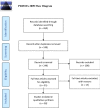Cure rate of infections is not an argument for spacer in two-stage revision arthroplasty of the hip
- PMID: 35534712
- PMCID: PMC10030410
- DOI: 10.1007/s00402-022-04463-9
Cure rate of infections is not an argument for spacer in two-stage revision arthroplasty of the hip
Abstract
Introduction: A devastating complication after total hip arthroplasty (THA) is chronic periprosthetic joint infection (PJI). Most frequently spacers (Sp) with or without antibiotics are implanted in a two-stage procedure even though not always indicated due to unknown pathogen, femoral and acetabular defects or muscular insufficiency.
Materials and methods: A retrospective analysis of a prospectively collected database was conducted, analyzing the treatment of 44 consecutive cases with chronic PJI undergoing two-stage revision using a Girdlestone situation (GS) in the interim period between 01/2015 and 12/2018. Diagnostics included intraoperative microbiological cultures, histological analysis, sonication of the initial implant, analysis of hip aspiration, as well as laboratory diagnostics and blood cultures. We analyzed the general and age-group-specific success rate of treatment using GS. Furthermore, we compared our data with the current literature on spacer implantation regarding common complications.
Results: In total, 21 female and 23 male patients at a mean age of 59.3 ± 9.6 years were included. Age groups were divided into young, mid-age, and elderly. In most patients, microbiology revealed Staphylococcus epidermidis in 39.1% of cases, following Staphylococcus lugdunensis and Staphylococcus aureus in 10.9% after THA explantation. For histology, Krenn and Morawietz type 2 (infectious type) was diagnosed in 40.9%, type 3 (infectious and abrade-induced type) in 25.0%. With GS, the total cure rate was 84.1% compared to 90.1% (range 61-100%) using Sp as described in the literature. Among age-groups, cure rate varied between 77.8 and 100%. Other complications, which only occurred in the mid-age and elderly group, included the necessity of transfusion in 31.1%, and in total, one periprosthetic fracture was identified (2.3%).
Conclusion: GS shows an acceptable cure rate at a minimum of 2 years when compared to the cure rate reported in the literature for Sp without major complications. For patients with increased risks for treatment failure using spacer, GS seems to be an alternative for chronic PJI when looking at the success rate of treatment.
Level of evidence: III, Retrospective trial.
Keywords: Complications; Cure rate; Girdlestone; Infection; Spacer; Total hip arthroplasty.
© 2022. The Author(s).
Conflict of interest statement
The authors have no relevant financial or non-financial interests to disclose.
Figures
Similar articles
-
The Influence of Spacer Design on the Rate of Complications in Two-Stage Revision Hip Arthroplasty.J Arthroplasty. 2019 Jun;34(6):1201-1206. doi: 10.1016/j.arth.2019.02.012. Epub 2019 Feb 15. J Arthroplasty. 2019. PMID: 30879874
-
Two-stage hip revision arthroplasty for periprosthetic joint infection without the use of spacer or cemented implants.Int Orthop. 2019 Nov;43(11):2457-2466. doi: 10.1007/s00264-019-04297-y. Epub 2019 Jan 18. Int Orthop. 2019. PMID: 30659319
-
Single-stage total hip arthroplasty after failed fixation of proximal femoral fractures: an increased risk for periprosthetic joint infections?Arch Orthop Trauma Surg. 2022 Oct;142(10):2911-2917. doi: 10.1007/s00402-021-04119-0. Epub 2021 Aug 28. Arch Orthop Trauma Surg. 2022. PMID: 34453205 Free PMC article.
-
Long-term clinical outcome of two-stage revision surgery for infected hip arthroplasty using cement spacer: Culture negative versus culture positive.J Orthop Surg (Hong Kong). 2018 Jan-Apr;26(1):2309499017754095. doi: 10.1177/2309499017754095. J Orthop Surg (Hong Kong). 2018. PMID: 29366392
-
Diagnosis and surgical treatment of chronic destructive septic hip arthritis.Arthroplasty. 2025 Apr 9;7(1):19. doi: 10.1186/s42836-025-00305-2. Arthroplasty. 2025. PMID: 40200351 Free PMC article. Review.
Cited by
-
Mouldable Collagen-Tricalciumphosphate Is a Safe Carrier for Local Antibiotics-Short-Term Results in Revision Hip Arthroplasty.Antibiotics (Basel). 2024 May 30;13(6):510. doi: 10.3390/antibiotics13060510. Antibiotics (Basel). 2024. PMID: 38927177 Free PMC article.
-
Short-term clinical effect of total hip replacement in the treatment of sequelae of septic arthritis of the hip: A retrospective study.Medicine (Baltimore). 2025 Jul 11;104(28):e43269. doi: 10.1097/MD.0000000000043269. Medicine (Baltimore). 2025. PMID: 40660575 Free PMC article.
References
Publication types
MeSH terms
LinkOut - more resources
Full Text Sources
Medical
Research Materials


